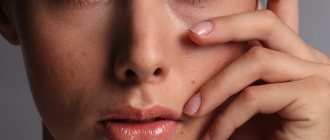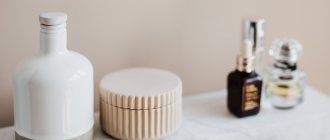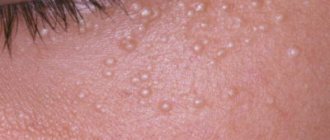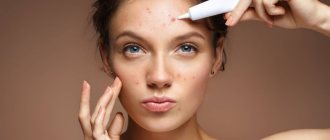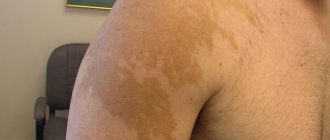Where is the T zone on the face?
Photo: Social networks
Zone-t is the forehead, nose and chin. If you draw a line on the forehead, and then from the center of the forehead draw a line along the nose to the chin, you will get a clear letter T.
This is our problem area - the face. This is where some strange pimples, blackheads, and flaking of the skin most often occur. According to statistics, 90% of facial skin problems occur in this area.
Causes of T-zone problems
With dry and normal skin, there are no problems or difficulties in caring for the skin of the T-zone. But if your skin type is oily or combination, zone T really causes a lot of inconvenience.
It is in the T zone that the activity of the sebaceous glands, which produce excess sebum, is increased. Excess sebum is the main cause of pimples, blackheads, and redness. The problem area is enlarged and contaminated pores, an accumulation of “blackheads”.
The T-zone is a special place where the skin requires a different approach to daily care.
How to get rid of the peeling problem
Find out the cause and, if possible, eliminate it.
Use as a cleanser for very dry and sensitive skin.
Instead of scrub or peeling, use moisturizing masks.
If possible, spray damaged areas with thermal water .
Provide the skin with maximum intense hydration.
Choose nourishing creams based on fatty acids for dry and sensitive skin.
Facial peeling is a seemingly harmless, but rather unpleasant problem that can occur at any age, in men and women. Most often this is caused by external influences, but sometimes peeling of the skin indicates a dermatological pathology. In such cases, you should clearly understand why the skin on your face is peeling, what to do, and in what cases you need to see a doctor.
Quick page navigation
How to care for the zone
There is an unspoken rule among cosmetologists that says that healthy skin is, first of all, clean skin. Any skin care should begin with cleansing it of dust and dirt.
The skin in the T-zone is relatively rough and covered with a sebaceous coating, so using plain water cannot achieve high-quality cleansing of the skin. It is best to use neutral toilet soap or gel for washing.
If the skin reacts poorly to soap or other cosmetics, you can use simple kefir or whey to wash your face.
✔ Fermented milk products have a unique ability to increase the acid barrier of the skin. After cleansing the skin with kefir or whey, microbes stop spreading.
✔ In the morning, apply kefir to the zone-t using a cotton pad, leave for five minutes, then rinse with warm water.
✔ Daily washing with vinegar water does a good job of removing excess sebum and increasing skin acidity. To prepare the solution, add one tablespoon of vinegar to one liter of water. You can simply wash your face with this water, or you can soak a cotton swab in it and wipe problem areas: forehead, bridge of the nose, wings of the nose, chin.
Of course, washing alone is not enough for complete care. Zone T is quite capricious and, unfortunately, a universal cosmetic product for its care has not yet been produced. But home care remedies are quite enough.
What to do first
If you have dry skin, your tendency to flaking is obvious. Proper care that matches individual characteristics will help you quickly cope with the problem. Some factors that may provoke this unpleasant process should be taken into account:
- washing with running chlorinated water (try to use purified water or herbal infusions);
- drying the face with a hard towel (gently blot the skin with a soft or paper towel);
- using toilet soap to cleanse the skin (use delicate products without alcohol: milk, mousse, foam, gel);
- scrubbing with aggressive agents (do not use scrubs with large particles; a soft oil-based scrub or peeling roller is better);
- lack of cream in daily care (be sure to apply immediately after cleansing a moisturizer with fatty components that protect against moisture loss).
When peeling, do not use a rough scrub with large abrasive particles so as not to injure the skin
Another important step is to review the diet, especially during the off-season, when every body is most susceptible to vitamin deficiency.
The following vitamins and microelements are responsible for skin health (foods with the highest content are indicated in brackets), which you should properly provide your body with:
- vitamins A, C (vegetables and fruits);
- vitamin E (vegetable oil, nuts, dried apricots);
- vitamin P (rose hips, black currants, oranges, cherries, pomegranate);
- vitamin B1 (sunflower seeds, nuts, bran);
- vitamin B6 (nuts, beans, tuna, mackerel, liver, sardine);
- vitamin B12 (liver, mussels, herring, meat, eggs);
- selenium (mushrooms, coconut, pistachios, eggs);
- zinc (liver, pine nuts, processed cheese, beef);
- potassium (dried apricots, beans, seaweed, peas);
- calcium (cheese, cottage cheese, milk);
- iron (seaweed, legumes, liver, apples);
- magnesium (nuts, cereals, seaweed, legumes).
Peeling skin can be a consequence of a lack of vitamins and minerals, so nutrition should be balanced
If peeling occurs in winter or after prolonged exposure to the scorching sun, it is worth adding appropriate products to your care: creams that protect the skin from cold, as well as with SPF from ultraviolet rays.
During the cold season, it is recommended to protect the skin from exposure to frost and wind using special creams
Important: you need to apply protective products 30–40 minutes before going outside, waiting until completely absorbed.
If peeling is accompanied by itching and redness, there is a high probability that the cause is an allergy to food, cosmetics, flowering plants, or medications. When the irritant is eliminated, the deficiency will disappear on its own. The use of antihistamines (Fenistil, Suprastin, etc.) will help speed up the process. An allergist will help determine this cause and prescribe an appropriate allergen recognition test .
Peeling accompanied by redness and itching may be a symptom of an allergic reaction.
To avoid an allergic reaction to a cosmetic product, before the first use it must be tested on the wrist or elbow for 24 hours. The absence of unpleasant reactions indicates the tolerability of the product and its possible use on the face.
Home remedies for deep skin cleansing
At home, peelings, scrubs and clay masks can be used to deep cleanse the T-zone.
Skin peeling
Before starting these home treatments, you need to wipe your face with a cosmetic tonic, then you need to steam the skin with a hot towel.
As soon as the skin has steamed and the skin pores become elastic, apply a face peeling cream or scrub to the area with a cotton pad. Give a short massage and rinse off the cleanser with cool water.
Deep cleansing with clay
Dilute one teaspoon of cosmetic clay with a few drops of water to a thick mass. Add a little lemon juice and a few drops of vodka. Mix the mass well.
Apply the resulting mixture to the area with a cotton pad and leave for 20 minutes. Then rinse with warm water.
Zone-t responds well to deep cleansing, but these procedures can be considered aggressive on the skin. Therefore, deep cleansing of the T-zone should be performed no more than once or twice a week.
Causes of peeling skin on elbows
The skin on the elbows is very sensitive and is most often exposed to various factors that negatively affect its condition.
It is worth highlighting the following factors that can contribute to the formation of peeling of the epidermis on the elbows:
- Physiological characteristics and mechanical effects. The skin on the elbows is constantly in motion. Almost every person daily affects the skin of their elbows in some way.
This could be moving your arms, resting on your elbows, and so on. The epidermis in the elbow area is thinner than in the rest of the arms, so the cells lose the necessary moisture much faster and become drier and quickly damaged. Regular contact of the skin with clothing is also of great importance; when the arm is bent, the skin on the elbows is subjected to friction against the fabric, resulting in damage.
- Exposure to the external environment - depending on the time of year, there are different effects on the skin of the elbows. For example, in the summer, ultraviolet rays deplete cells and lead to dryness and premature aging. In winter, cold air leads to peeling and cracks in the epidermis.
- Chemical irritants and water - the use of various body care products containing alkalis and other chemical detergent components that destroy the structure of the skin on the elbows and lead to the formation of various problems. Long-term exposure to water also negatively affects the condition of the elbows, which most often slows down the regeneration of damaged cells and leads to peeling. You should also know that water contains various additional components, for example, chlorine, which reduce the protective functions of the skin, thereby destroying it.
- Health problems – a violation of any functions in the body can negatively affect the general condition of the skin and require special care and treatment. Diabetes – this type of disease does not allow the body to be supplied with the necessary amount of vitamins, due to which the skin becomes thinner and more often subject to damage.
In diabetes mellitus, the epidermis cannot renew damaged cells in a timely manner, therefore, in places of greatest mechanical impact, skin compactions can form, which leads to peeling.
- Disruption of the thyroid gland (hypothyroidism) - the lack of the required amount of hormones negatively affects the condition of the skin of the elbows.
- Psoriasis and other skin diseases - diseases of this type deplete the skin and lead to its destruction and peeling.
- Insufficient amounts of vitamins – the lack of essential vitamin elements (such as vitamin D, E, A, B) can contribute to increased levels of dry skin. Often, with a lack of vitamins, it is the skin on the elbows that suffers and signals a problem to a person by peeling and the appearance of cracks.
Each human body may have its own individual characteristics, which may cause problems with the epidermis on the elbows. Therefore, to identify the causes and factors that contributed to this deficiency, it is recommended to consult a specialist and carefully monitor the skin’s reaction to various factors.
Tips for caring for the area
Photo: Pixabay
✔ Steam baths with infusions of medicinal herbs, such as chamomile, are very useful. Steam expands the pores and they are freed from dust, dirt, and excess sebum.
✔ Our skin loves both warmth and cold, it needs them equally. To narrow the pores of the skin, it is useful to wipe the area with pieces of ice several times a week before going to bed.
✔ Use drying and antibacterial lotions and tonics with zinc oxide or salicylic acid for daily care.
✔ 10 minutes before washing it is useful to wipe the area with cabbage juice.
✔ Pamper your facial skin with toning treatments several times a week and the problem area will thank you. Add the juice of one aloe leaf to a glass of mineral water and stir. Wipe with this product not only the t-zone, but also your cheeks and neck. This is a very good product for any skin type.
✔ Never squeeze pimples. A squeezed pimple will not go away and the inflammation will only drag on. A simple infusion of orange and tangerine peel will help fight acne in the T-zone. Brew some citrus peels with boiling water and let it brew. The infusion can be used for washing in the morning and wiping inflamed areas of the skin. This infusion can even be used for lotions.
✔ If the T-zone is very oily, do not go to the solarium, these procedures will only harm you.
Daily care lotion
You can prepare your own rescue lotion for the T-zone; to prepare it you will need benzoic acid, menthol, camphor alcohol, chamomile, sage, vodka and food grade acetic acid.
Dissolve 2 ml of benzoic acid, 0.25 grams of menthol in 30 ml of camphor alcohol. Add 2 tablespoons of chamomile or sage flowers, a glass of vodka, 200 ml of water and 5 ml of acetic acid. Mix the ingredients.
Use the lotion twice a day to wipe problem areas of the skin. The lotion should be stored in the refrigerator.
Masks for zone-t
Photo: Pixabay
Zona-t responds well to additional care. Masks can be performed once or twice a week. Before the procedure, the skin of the face must be cleansed with toner so that dirt is not absorbed into the skin along with the beneficial ingredients of the mask. The mask should not be applied to the eye area.
Tea mask
Mix one teaspoon of dry green tea, 4 drops of tea tree essential oil. Close the container and leave for a day. Then pour a glass of boiling water over the mixture and strain after 40 minutes. Add one tablespoon of lemon juice and ground rolled oats to the infusion until a thick mixture is formed. Apply the mask for 20 minutes, rinse with tea.
Egg mask
✔ Beat one egg white, add ground rolled oats and 3 drops of tea tree essential oil. Apply the mask to your face, wait until it dries and rinse with cool water.
✔ Grate one apple, add whipped egg white. Apply the mask to your face, leave for 15 minutes, then rinse with warm water.
✔ Soften strawberries or wild strawberries, add whipped egg white. Apply the mask to your face in several layers. After 15 minutes, rinse with cool water.
✔ Beat 1 egg white, add one teaspoon of cranberry juice and one teaspoon of starch. Apply the mask on your face for 15 minutes, rinse with warm water.
Kefir mask
Grind 5 tablespoons of green tea and add 3 tablespoons of kefir. Mix the mixture and apply to your face. Rinse off after 15 minutes with warm water.
Honey mask
Mix 1 teaspoon each of honey, potato starch, warm milk and salt. Apply the mixture in several layers, rinse with warm water after 25 minutes. Then rinse with cool water and lemon juice.
Cucumber mask
Grate the cucumber, add boric acid. Apply the mixture to your face and leave for 15 minutes. Then rinse with warm water.
Creamy mask
Steam your face first. Grind the plum fruits and add rolled oats flour. Apply the resulting paste in a thick layer to the skin of the face and neck. Leave the mask on for 15 minutes, rinse with warm water.
The T-zone will no longer be a problem if you take care of it especially carefully. There is no skin problem that cannot be dealt with.
If home remedies do not give a positive effect, then something is being done incorrectly. A consultation with a cosmetologist will help you find out and understand skin problems, and traditional medicine recipes will never be superfluous.
The skin on the elbows peels off in children
Children's skin, unlike adults, has a higher level of sensitivity, so various effects on the body can negatively affect the condition of the epidermis.
Itching and peeling may occur for the following reasons:
- External factors: allergic reactions to chlorine;
the body's reaction to alkali and other components found in body care products;
- reaction to household chemicals;
- tight clothing made from thick fabrics;
- dry indoor air;
- exposure to ultraviolet rays on the skin;
lack of vitamins;
If dry elbows occur in childhood, experts recommend visiting a therapist to prescribe the necessary type of treatment.
